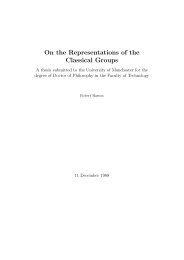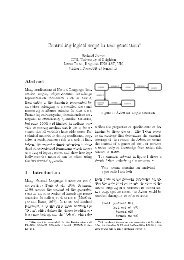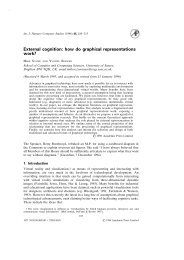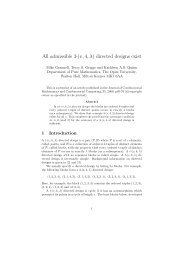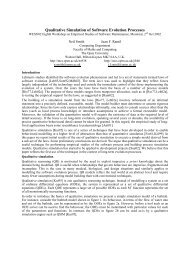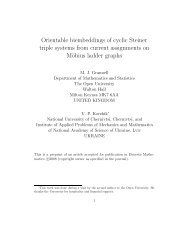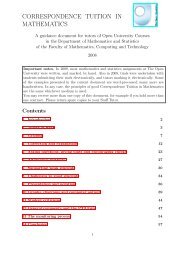Maximizing the number of Pasch configurations in a Steiner triple ...
Maximizing the number of Pasch configurations in a Steiner triple ...
Maximizing the number of Pasch configurations in a Steiner triple ...
Create successful ePaper yourself
Turn your PDF publications into a flip-book with our unique Google optimized e-Paper software.
(exclud<strong>in</strong>g <strong>the</strong> common <strong>in</strong>f<strong>in</strong>ity block) is 3(v −3). By apply<strong>in</strong>g this result<br />
for α = 1,2,3, it is apparent that 9(v−3) must be subtracted from (v−3) 2<br />
to take account <strong>of</strong> <strong>Pasch</strong> <strong>configurations</strong> conta<strong>in</strong><strong>in</strong>g an <strong>in</strong>f<strong>in</strong>ity po<strong>in</strong>t. Note<br />
thisalsotakes<strong>in</strong>toaccount<strong>the</strong>doublecount<strong>in</strong>g<strong>of</strong>those<strong>configurations</strong>with<br />
an <strong>in</strong>f<strong>in</strong>ity po<strong>in</strong>t that have been counted twice because <strong>the</strong>y have blocks<br />
from P1 and P2, or from P1 and P3, or from P2 and P3.<br />
Itrema<strong>in</strong>stodeterm<strong>in</strong>e<strong>the</strong><strong>number</strong><strong>of</strong><strong>Pasch</strong><strong>configurations</strong>thatconta<strong>in</strong><br />
blocks from Pi and Pj ((i,j) = (1,2),(1,3),(2,3)), but no <strong>in</strong>f<strong>in</strong>ity po<strong>in</strong>t,<br />
s<strong>in</strong>ce <strong>the</strong>se have been subject to multiple count<strong>in</strong>g. Such a <strong>Pasch</strong> configuration<br />
must conta<strong>in</strong> blocks from all four parallel classes and, as shown <strong>in</strong><br />
<strong>the</strong> pro<strong>of</strong> <strong>of</strong> Lemma 2.3, <strong>the</strong> <strong>number</strong> <strong>of</strong> such <strong>configurations</strong> is (v−3). Each<br />
is counted 3 times, once for <strong>the</strong> block <strong>in</strong> P1, once for <strong>the</strong> block <strong>in</strong> P2, and<br />
once for <strong>the</strong> block <strong>in</strong> P3. So a fur<strong>the</strong>r 2(v − 3) must be subtracted from<br />
(v−3) 2 to take account <strong>of</strong> multiple count<strong>in</strong>g <strong>of</strong> <strong>Pasch</strong> <strong>configurations</strong>hav<strong>in</strong>g<br />
blocks from all four parallel classes.<br />
Thus<strong>the</strong><strong>number</strong><strong>of</strong><strong>Pasch</strong><strong>configurations</strong><strong>in</strong>S2k hav<strong>in</strong>gatleastoneblock<br />
from P1 or P2 or P3, but no <strong>in</strong>f<strong>in</strong>ity po<strong>in</strong>ts, is (v−3) 2 −9(v−3)−2(v−3) =<br />
(v −3)(v −14).<br />
It follows that for k ≥ 2, <strong>the</strong> <strong>number</strong> <strong>of</strong> <strong>Pasch</strong><strong>configurations</strong> <strong>of</strong> S2k that<br />
conta<strong>in</strong> one <strong>of</strong> <strong>the</strong> <strong>in</strong>f<strong>in</strong>ity po<strong>in</strong>ts, or a block from P1 or P2 or P3 is<br />
(3v −14)(v −3)<br />
4<br />
+(v −3)(v −14) =<br />
7(v −3)(v −10)<br />
.<br />
4<br />
The second step <strong>in</strong> obta<strong>in</strong><strong>in</strong>g <strong>the</strong> <strong>Pasch</strong> count for Uk is to determ<strong>in</strong>e <strong>the</strong><br />
<strong>number</strong> <strong>of</strong> <strong>Pasch</strong> <strong>configurations</strong> added by <strong>the</strong> <strong>in</strong>clusion <strong>of</strong> <strong>the</strong> new blocks.<br />
Lemma 2.7 For k ≥ 2 <strong>the</strong> new blocks lie <strong>in</strong> a total <strong>of</strong><br />
<strong>Pasch</strong> <strong>configurations</strong> <strong>in</strong> Uk.<br />
(v −3)(9v −85)<br />
12<br />
Pro<strong>of</strong> As <strong>in</strong> <strong>the</strong> pro<strong>of</strong> <strong>of</strong> Lemma 2.4, consider first a pair ab that is not<br />
covered by <strong>the</strong> parallel class P <strong>in</strong> S2k−2. Suppose that this pair lies <strong>in</strong> a<br />
block abx <strong>in</strong> that system. The <strong>number</strong> <strong>of</strong> <strong>Pasch</strong> <strong>configurations</strong>that conta<strong>in</strong><br />
twoblocks<strong>of</strong><strong>the</strong> formaijahℓN, bpqbrsN andtw<strong>of</strong>ur<strong>the</strong>rblocksobta<strong>in</strong>edby<br />
subscript<strong>in</strong>g abx appropriately is, as shown previously <strong>in</strong> Lemma 2.4, 3(v−<br />
3)(v−15)/4. However,unlikeLemma 2.4, <strong>the</strong>re areno <strong>Pasch</strong><strong>configurations</strong><br />
conta<strong>in</strong><strong>in</strong>g exactly two blocks <strong>of</strong> <strong>the</strong> form aijahℓN, bpqbrsN when abc is a<br />
block <strong>of</strong> P.<br />
Next consider <strong>the</strong> 54 blocks <strong>in</strong> Table 2, toge<strong>the</strong>r with <strong>the</strong> 12 blocks <strong>of</strong><br />
<strong>the</strong> STS(9) on <strong>the</strong> colours. An exhaustive search shows that <strong>the</strong>re are 60<br />
<strong>Pasch</strong><strong>configurations</strong>that have<strong>the</strong>ir four blockstaken from <strong>the</strong>se 66blocks.<br />
None<strong>of</strong><strong>the</strong>se <strong>Pasch</strong><strong>configurations</strong>comesfrom<strong>the</strong> STS(9)itself. Thus each<br />
block abc ∈ P <strong>in</strong> S2k−2 gives rise to 60 dist<strong>in</strong>ct <strong>Pasch</strong> <strong>configurations</strong>, and<br />
10



